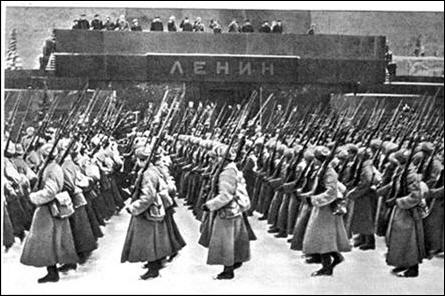General Works
Soviet Armed Forces Review Annual (SAFRA).
Jones, David R., (ed.) 1977-1989
U of I Library Call Number: Main Stacks Reference and Oak Street Facility 355.00947 SO895
title changed to:
Russia and Eurasia Armed Forces Review Annual [REAFRA].
Karasik, Theodore W., (ed.) 1990-.
U of I Library Call Number: Main Stacks Reference 355.00947 SO8951
This annual publication gives a very in-depth and well-researched account of the issues related to the Soviet, and later, Russian, military. The articles cover all branches of the armed forces and the military-industrial complex, as well as the socio-political aspects of Russia’s military. Historical, retrospective pieces on the development of Russian military thought are presented as well as highly technical articles on specific types of armament. The volumes are divided into subject sections. Some of the sections such as “Military indicators” are permanent. Another section which is very rich in materials for a researcher is the permanent bibliography section, found in the volumes apart from the bibliographies of sources used, presented after each chapter.
A review described the series as “A unique publication concerned with assessment of Soviet [and now Russian and Eurasian] capabilities and theory rather than an enumeration of equipment as in the Jane’s series” [Choice]
Since its first volume the publication has totaled over 4700 pages. The latest published volume is for year 1991. The volume for 1992-3 is in preparation.
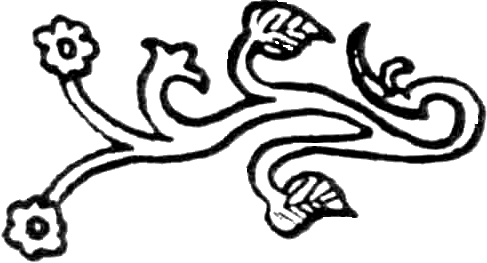
The Armed Forces of the USSR.
Scott, Harriet Fast and William F. Scott., Boulder: Westview Press; London: Arms and Armour Press, 1984. Third edition, revised and updated.
U of I Library Call Number: Main Stacks and Oak Street Facility 355.00947 SCO8402A1984
The book begins with a prologue chapter which traces the development of the Soviet military power from the October Revolution to the end of WWII. The bulk of the work however focuses mostly on the Soviet forces as they were at the time of publication.
The authors relied to a great extent on the Soviet military sources, and thus do not mirror other US publications of the time. The volume discusses a broad range of aspects of the Soviet military establishment — from the structure of the military services and their training to the integration of the military-industrial complex into the Soviet life. The interrelationships of the military and the Communist Party are also highlighted, as is the overriding importance of Soviet military doctrine on all aspects of military life. The book closes with a chapter “Weighing the Balance” which sounds a dire warning of the threat the Soviet military poses to the West and China.
Each chapter closes with rich bibliographical notes and there is a Selected Bibliography section appended at the end of the volume. There are also name and subject indexes, as well as several appendices, including one on women in the Soviet armed forces.
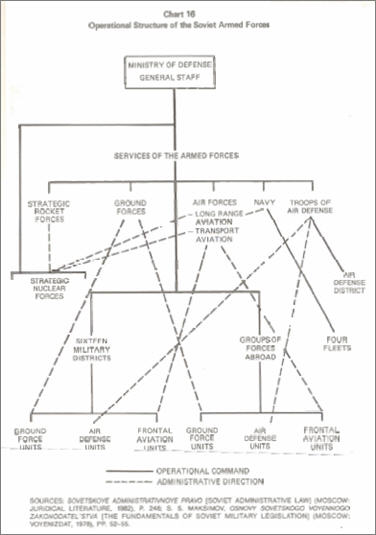

Fronty, floty, armii, flotilli perioda Velikoi Otechestvennoi voiny 1941-1945 gg.: Spravochnik.
Zhukovskii, M., Moskva: Kulikovo pole, 2003.
U of I Library Call Number: International & Area Studies Russian Reference (Slavic) 940.5347 F928
The work presents in a brief reference format the operational makeup of the Soviet army in the years 1941-1945. It is divided into the following sections: fronts, air defense fronts, navy fleets, combined-arms armies, tank armies, sapper armies, air armies, air defense armies, and navy flotillas. Each entry contains the history operational unit, with the date and circumstances of its inception, the names of commanding officers, brief outline of participation in the war, as well as decorations it may have received as a whole, as well as some information on decorations received by individual soldiers.
A separate part of the work provides a complete listing of the Soviet units at the level of corps and division (and their naval equivalents) for the period 1941-1945. The units are grouped by branch of arms and within then are listed by unit number.
There is also a table showing all the Soviet fronts of WWII with their dates of inception and renaming, regrouping, or dissolution.
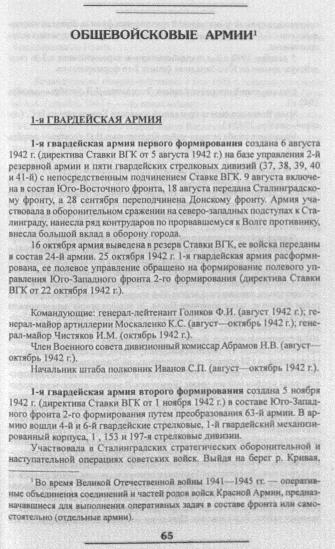

Atlas kart i skhem po russkoi voennoi istorii.
Beskrovnyi, L.G., Voennoe izd-vo Narodnogo komissariata vooruzhennykh sil Soiuza SSSR, 1946. 88 plates.
U of I Library Call Number: Main Stacks 355.0947 B46MKMAPS
The atlas shows maps and diagrams of Russian military history beginning with the wars of Kievan Rus’, all the way to the Russo-Japanese war. The arrangement of material follows the program of Soviet military academies. The work is divided into chapters corresponding to historical periods, with each chapter containing: a map of the Russian state at the time, a graphic representation of the organization of the Russian armed forces of the period, order of battle, and maps of major engagements.
All the maps have been prepared on the basis of “Khrestomatiia po russkoi voennoi istorii.”
All the text referring to the Russian military is written in a regular font, while the text concerning the opposing forces is written in italics. All symbols referring to the Russian army are presented in red, symbols of foreign forces, in blue. All dates for the events until the end of the XVIIth century are given according to the old calendar, all dates from the beginning of the XVIIIth century are given using the ‘new style.’
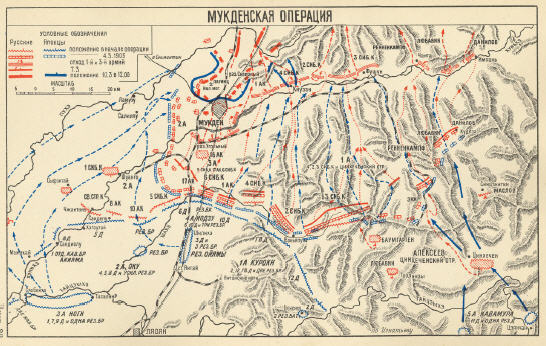

Ocherki po istochnikovedeniiu voennoi istorii Rossii.
Beskrovnyi, L.G., Moskva: Izd-vo Akademii Nauk SSSR, 1957.
U of I Library Call Number: Main Stacks 947 B463O
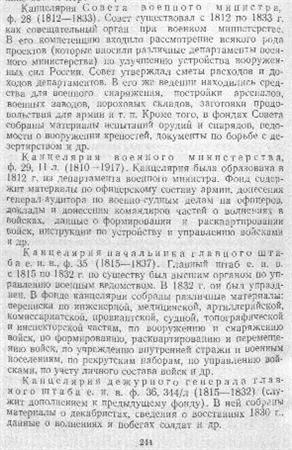
This work traces written historical military sources, from the origins of the Russian state until the end of WW I. The types of materials discussed include documentary items such as laws, directives, orders, and reports. Included also are theoretical treatises, as well as materials of a more literary type, such as chronicles, tales, and memoirs. The scope of materials encompasses strategy, operational art, and tactics (general and for various types of units).
The work is divided into seven main parts: Sources on military affairs of the ancient Slavs, Military sources from the early Russian state (IX-XI centuries), Military and historical sources the period of feudal splintering of Rus’ (XII-XIV centuries), Military and historical sources from the period of the Russian centralized state (XIV-XVII centuries), Military and historical sources from the absolute monarchy (XVIII century), Military and historical sources from the first half of the XIX century, Military and historical sources from the second half of the XIX century and the beginning of the XX century.
Unfortunately, the work does not contain an index, and is, therefore, not too easy to navigate. However, it does provide a good overview of the sources pertaining to a particular period and is well worth the researcher’s time.

Katalog Voenno-uchenago arkhiva Glavnago Shtaba.
Sost. M. O.Bender, red Vivien-de-Chateaubriand., S.-Peterburg: Tip. “Berezhlivost”, 1905, 3 vols.
U of I Library Call Number: International & Area Studies Russian Reference (Slavic) and Oak Street Facility 016.3550947 R92K
The history of the Voenno-Uchenyi Arkhiv Glavnogo Shtab begins in1797 with the Imperial order putting all maps, plans and other archival materials in possession of the General Staff into the newly founded His Imperial Majesty’s Depostiory of Maps (Sobstvennoe Ego Imperatorskogo Velichestva Depo Kart). After many name changes the depository was renamed to its current name in 1867.
The double numeration of the entries is a result of the history of the catalog, the compiling and printing of which was at one point interrupted, with new materials entering the archive all the time and some old materials not included in the original printing having been found during the check. The new numbers are marked with bold print.
Today’s name of the archive is Rossiiskii gosudarstvennyi voenno-istoricheskii arkhiv (RGVIA). The collecton of the archive reflects the history of the Russian armed forces from the beginning of the XVIIIth century until the beginning of the XXth.
For materials regarding the Red Army one should consult the Rossiiskii gosudarstvennyi voennyi arkhiv (RGVA) established in 1920 as the Arkhiv Krasnoi Armii.
The naval history of Russia and the Soviet Union can be traced using Rossiiskii gosudarstvennyi arkhiv Voenno-Morskogo Flota (RGAMF), established in 1724 as Arkhiv Gosudarstvennoi Admiralteistv0kollegii).
Other major military archives include:
Tsentralnyi arkhiv Ministerstva oborony Rossiiskoi Federatsii (TsAMO) (est. in 1936 as Otdel arkhivov Narodnogo komissariata oborony SSSR).
Tsentralnyi arkhiv vnutrennikh voisk Ministerstva vnutrennikh del Rossiiskoi Federatsii (TsAVV), est. in 1923 as Boennyi arkhiv pri Shtabe voisk GPU-NKVD-MVD RSFSR-SSSR.
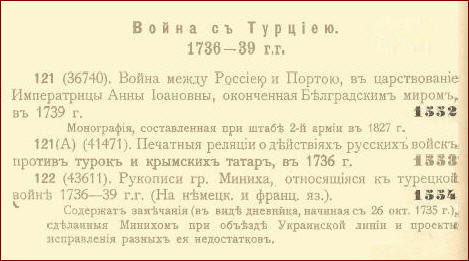

Encyclopedias and Dictionaries
The Military-Naval Encyclopedia of Russia and the Soviet Union.
Jones, David R., Gulf Breeze, FL: Academic International Press, 1978-
With Volume 5 the title changes to:
Military Encyclopedia of Russia and Eurasia (MERE).
U of I Library Call Number: Oak Street Facility 355.00947 M599
The scope of the encyclopedia is very broad since its creators treat the term military “in its broadest sense, the military aspect is visible in all areas of Russian and Soviet history blurring the line between civilian and martial.
The ambitious concept of this encyclopedia is perhaps the reason for the first eight volumes not having gone beyond the letter “A.” Many of the entries are so detailed that they are more like in-depth articles rather than encyclopedia entries. Thus, for example volume 2 consists of two long articles under the heading, “Administrative System and Policy-making Process, Central Military,” while volume 8 is basically a monograph titled “Aerial Bomb,” covering the development of this weapon from Imperial Russia until the late 1990s.
The encyclopedia is rather sparsely illustrated with drawings and photographs. Each entry ends with a well-developed bibliography of sources.

Entsiklopediia Voennoi Razvedki Rossii.
Author/compiler A.I. Kolpakidi, Moskva: AST, Astrel, VZOI, 2004.
U of I Library Call Number: International & Area Studies Russian Reference (Slavic) and Main Stacks355.34320947 K834e
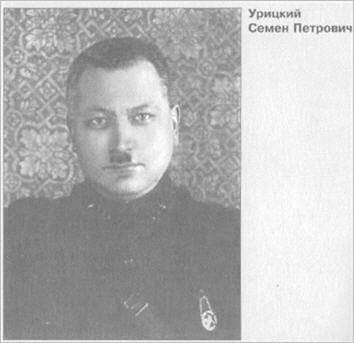
The work is organized into three parts. Part I, comprising some one hundred pages, gives the historical sketch of the evolution of Russia’s military intelligence from the times of Peter the Great until the 21st century. Biographies of the leaders of the military intelligence are woven into the narrative. In this part and throughout the work, the names of agents and historical figures are printed in bold, which greatly helps in locating them.
Part II, the bulk of the work, is divided geographically – it shows the involvement of Russian military intelligence in various countries of the world, which are arranged alphabetically. The entries for each country give a chronological sketch of the Russian intelligence activity in that country. As in Part I, the narrative is interspersed with biographical entries on heads of the directorate and the more important agents.
Part III consists of four appendices. The first contains a brief sketch of the activities of the military intelligence on the Soviet territory occupied by Germans during WWII. The second part of the appendix briefly highlights various aspects of Soviet military intelligence during WWII, including information gathered for particular battles and campaigns, as well as the role of the partisans in information gathering and sabotage.
Part three of the appendix deals with the history of the so called “aktivnaia razvedka,” or spetsnaz units working directly under the direction of the GRU, specializing in diversion, sabotage and other types of special military operations.
The work is illustrated by 26 black-and-white portraits of XXth century leaders of the military intelligence.

Morskoi entsiklopedicheskii slovar.
Dmitriev, V.V. (ed)., Leningrad: “Sudostroenie,” 1991.
U of I Library Call Number: International & Area Studies Russian Reference (Slavic) 359.003 M837
Although the dictionary has a general character and discusses all matters maritime, among its 7000 entries it also contains a considerable amount of information on the history of Russian and Soviet navies. There are entries on particular battles, battleships, types of armament, naval flags, uniforms, as well as biographies of outstanding commanders.
The arrangement of the dictionary is alphabetical; the dictionary is well illustrated with both drawings and color plates.
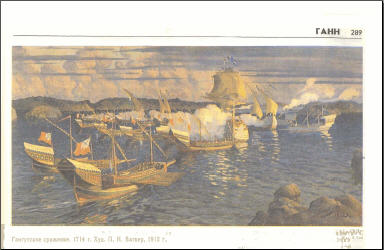

Grazhdanskaia Voina i voennaia interventsiia v SSSR. Entsiklopediia.
Khromov, S.S.(ed.), Moskva: Sovetskaia Entsiklopediia, 1983.
U of I Library Call Number: International & Area Studies Russian Reference (Slavic) 947.0841 G79521983
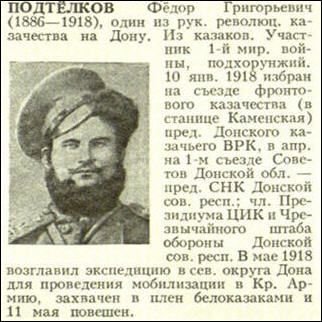
The encyclopedia was published as a supplement to the Encyclopediia “Velikaia Oktiabrskaia sotsialisticheskaia revoliutsiia” and it focuses on the years 1918-1920. Among the 2700 entries, which inevitably contain the entries on Lenin and his work, we find several of a strictly military nature, discussing military operations of all sizes, participation of various units, histories of voennye okrugi, as well as biographical entries of soldiers.
The arrangement is alphabetical, the work is well illustrated with maps, tables, photos, and several colored plates.

Sovetskaia Voennaia Entsiklopediia.
Voennoe Izdatel stvo Ministerstva Oborony SSSR, 1976-1980. 8 vols.
U of I Library Call Number: Main Stacks Reference 355.03 SO892
This huge undertaking encompasses some 10,000 entries from all areas of military science, from historical events to technical details of equipment. When consulting the encyclopedia one has to keep firmly in mind that all articles, except for those written on purely technical subjects, are heavily influenced by the Soviet political doctrine of the time. This refers to the majority of subject including the biographies of military figures, especially those who were subject to political purges. History of WWII has been varnished to conform to the official historiography of the time, with major omissions of facts, glossing over “controversial” subjects, or skipping entire major subjects altogether. Nevertheless, if one keeps the very strong political bent in mind, the encyclopedia is a valuable research tool, especially in the more technical areas of military science and in the “non-controversial” areas, such as for example histories of particular military units.
The encyclopedia is richly illustrated with photos, graphs, charts, and maps (many in color).

Voennaia entsiklopediia.
Velichko, K.I. and V. F. Novitskii et al (eds.), Peterburg : T-vo I.D. Sytina, 1911-1915.
U of I Library Call Number: Oak Street Facility 355.03 V857. This source is also available electronically through our catalog. Follow this link to gain access to the source.
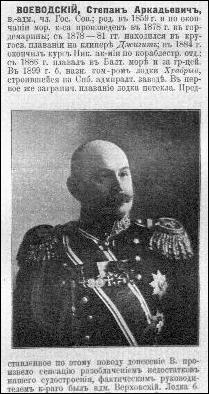
The publication of this monumental encyclopedia, originally planned to comprise 25 volumes, was interrupted twice. First by the start of WWI and then by the revolution, which terminated the publication. The last volume published is number 18 (Pauker G.E. – Port Artur). The work, written by the greatest Russian military theoreticians of the time, contains 9,156 entries, 4847 illustrations, and over 1000 maps.
Besides articles on Russian military history and science the encyclopedia contains entries on foreign military figures.
The work has been republished in paper format by the Reitar publishing house in 2007. (There is some discussion of possibly publishing the volumes 19-25). The encyclopedia is also available in DVD format (“Bolshaia entsiklopediia. Voennaia entsiklopediia,” Biznessoft, 2007).

Voennaia entsiklopediia.
Novitskii, V.O., ed., Sankt-Peterburg: Izd-vo I.D. Sytina, 1911-1915. 18 vols.
U of I Library Call Number: Slavic Reference 355.03 V857 v.1-18
The work, grand in scope and design, was meant to encompass all military matters, not only those related to Russia’s military. It includes entries on other nations’ military events and figures, as well. Nevertheless, for the scholar of Russian military history it provides rich biographical and factual material.
The work is lavishly illustrated with photographs, reproductions of artwork depicting military themes, as well as several color maps and battle and campaign diagrams. The encyclopedia was never completed. It ends with the letter “P” (the last entry is Port Artur).
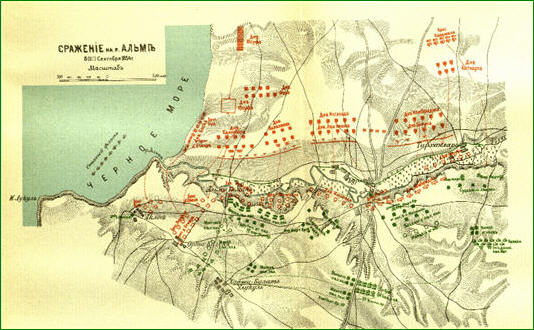

Voennyi entsiklopedicheskii leksikon, izdavaemyi Obshchestvom voennykh i literatorov. Izd. 2-e.
Zeddeler, L.I. and I.I. Grech (eds.), Sanktpeterburg: Tip. Shtaba voenno-uchebnykh zavedenii, 1852-
U of I Library Call Number: Oak Street Facility 355.03 V8572 (Volume 4 is shelved at Main Stacks).
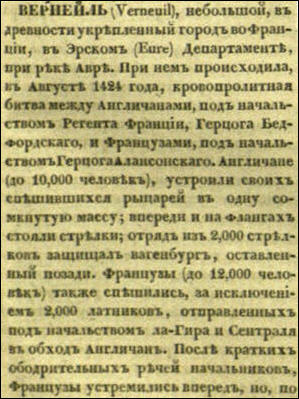
This military lexicon, unlike many early Russian encyclopedic efforts, was brought to completion, although the publication of its first edition took 14 years. The final volume of the first edition was finally completed in 1850 (thanks largely to the titanic efforts and sacrifices of its editor, general L.I. Zeddeler).
The list of authors working on the lexicon shows many names associated with the pioneering (albeit never completed) work of A.A. Pliushar’s “Entsiklopedicheskii leksikon.” As a matter of fact, some of the entries in the Voennyi entsiklopedicheskii leksikon have been transferred directly from Pliushar’s lexicon.
In the foreword the authors delineate the scope of the encyclopedia, vowing to exclude all that “does not have something to do with military matters,” and for the most part stick to this pledge. In the work we find articles on the history and theory of military arts (including military technology), history of wars and campaigns, as well as biographies of famous military leaders. Since the lexicon was based in part on similar German and French works, it includes many entries on European wars and European military figures. However, there is a strong emphasis on Russia, including the history of its military institutions and biographies of leaders. In writing the Russia-related entries the writers were breaking new ground, making heavy use of archival materials.
The work was extremely well received and was showered with accolades – the Russian Academy proclaimed it to be the best military-themed work of its time, and L.I. Zeddeler in 1852 was awarded the polnaia Demidovskaia premiia of 1428 silver rubles. This would have gone far towards restoring his fortune lost in the publication of the work. Unfortunately, he was already dead.

Russkii voenno-istoricheskii slovar.
Krasnov, V. and V. Daines, Moskva: “Olma-Press,” 2001.
U of I Library Call Number: International & Area Studies Russian Reference (Slavic) 355.00947 K864r
This encyclopedic dictionary focuses on Russian military history from the beginnings of the Russian state until 1917. The dictionary has over 2000 alphabetically arranged entries. It is generously illustrated with maps, drawings, photos and reproductions of paintings. The dictionary covers all aspects of military history from types of weaponry and uniform, battles and campaigns, to biographies of military leaders.
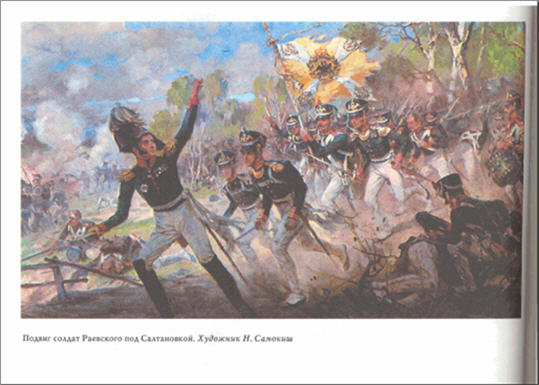

Velikaia Otechestvennaia voina 1941-1945. Entsiklopediia.
Kozlov, M.M.(ed.), Moskva: Sovetskaia entsiklopediia, 1985.
U of I Library Call Number: International & Area Studies Russian Reference (Slavic) 940.534703 V545
The encyclopedia was published on the 40th anniversary of Soviet victory in WWII. It covers all aspects of the war, of course with a heavy overlay of the official propaganda point of view. There are, as one would expect, numerous entries devoted to strictly military matters such as descriptions of campaigns, battles, technical data on weapons, and biographies of famous military figures, both high-ranking commanders and highly-decorated soldiers. However, great amount of space has also been devoted to the work at the rear of the front in the areas such as industry, transport, etc. One finds lengthy entries on the more important factories and biographical entries on the leaders of industry the communist work effort. There are also entries, many biographical, reflecting the state of science and art during the war years, including the cinema production. The encyclopedia is very richly illustrated with black and white photos, as well as color plates of posters, works of art, operational maps, etc.
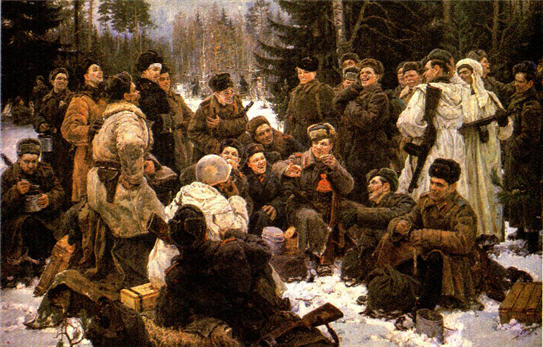

Velikaia Otechestvennaia voina, 1941-1945: Slovar-spravochnik.
Andronikov, N.G. et al., Moskva: Politizdat, 1985.
U of I Library Call Number: Oak Street Facility 940.53039171 V544
This work, written by the staff of the Institut voennoi istorii Ministerstva oborony SSSR is meant as a quick reference source, providing some 2000 alphabetically arranged entries on all aspects of WWII. Appended are a brief bibliography at the end of the work (with a subsection of memoir literature), as well as a relatively extensive chronology of the war.


Otechestvennaia voina 1812 goda: Entsiklopediia.
Moskva: ROSSPEN, 2004.
U of I Library Call Number: International & Area Studies Russian Reference (Slavic) 940.27 Ot2
This large, richly illustrated volume, covers all aspects of the Russian-French war of 1812. There are over 1000 entries devoted to all aspects of the war, from major battles, military units, to details of uniform and armament. There are also some 1000 entries on the major figures of the war, not limited to military men but also including government officials, memoirists, historians, writers and artists who used the theme of the war in their works.
The encyclopedia includes a chronology of the 1812-1814 war and the campaign of 1815. There is also a brief dictionary of military terms and weapons, parts of uniform and other military equipment.
Over 100 researchers contributed to the encyclopedia entries. Submissions were also solicited from Ukraine, Poland and France.
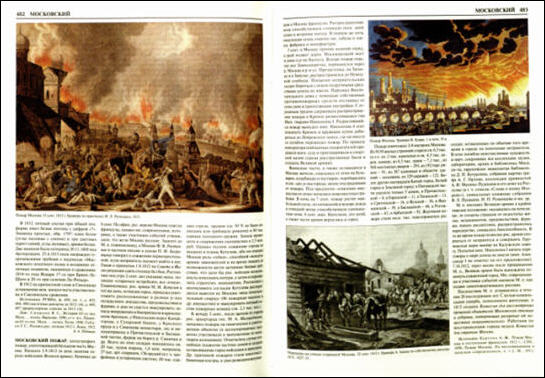

Velikaia Otechestvennaia voina, 1941-1945: Slovar-spravochnik.
Andronikov, N.G. et al., Moskva: Politizdat, 1985.
U of I Library Call Number: Oak Street Facility 940.53039171 V544
This work, written by the staff of the Institut voennoi istorii Ministerstva oborony SSSR is meant as a quick reference source, providing some 2000 alphabetically arranged entries on all aspects of WWII. Appended are a brief bibliography at the end of the work (with a subsection of memoir literature), as well as a relatively extensive chronology of the war.

Slovar osnovnykh voennykh terminov.
Moskva: Voenizdat, 1965.
U of I Library Call Number: International & Area Studies Russian Reference 355.03 V98s
English translation: Dictionary of basic military terms: a Soviet view / Washington: Published under the auspices of the United States Air Force, 1976.
This dictionary of basic military terminology was aimed as a reference book for the officers of all the branches of the Soviet armed forces. It provides brief definitions of terms from the technical, political and historical spheres of Soviet military science.
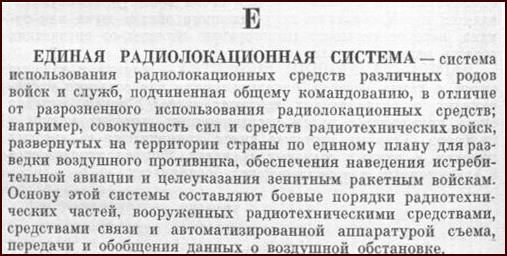

Bibliographies
SSSR v gody Velikoi Otechestvennoi voiny (iiun 1941 – sentriabr 1945 g.): ukazatel sovetskoi literatury za 1941-1967 gg.
Moskva: Nauka, 1977. OCLC: 7926929
- SSSR v gody Velikoi Otechestvennoi voiny (iiun 1941-sentiabr 1945 g.) Ukazatel sovetskoi literatury za 1941-1967 gg. Prilozhenie. Skhema klassifikatsii. Vspomagatelnye ukazateli.
Moskva: Nauka, 1977. - SSSR v gody Velikoi Otechestvennoi voiny (iiun 1941-sentriabr 1945 g.). Geroi fronta i tyla. Ukazatel sovetskoi literatury za 1941-1967 gg.
Moskva: Nauka, 1981.
This guide is a continuation of the retrospective historical bibliography “Istoriia SSSR” published by the Soviet Academy of Sciences in 1956-1958. The bibliography includes a very broad spectrum of materials. Listed are books, articles, bibliographies, collections (sborniki) of all types, dissertation abstracts, conference papers, university lectures, book reviews, and memoir literature.
The arrangement of the text is by subject. (The choice of subject groupings may appear somewhat arbitrary, however it was created to reflect “the structure of the contemporary Soviet historical science”). Within each of the subject divisions one finds permanent subdivisions of: Bibliografiia, Spravochnye materially, Istoriografiia, Istochnikovedenie-Obzory fondov, Istochniki (with subd. Vospominaniia). Within these subdivisions entries are listed chronologically by date of publication, and within each year alphabetically by author and title. Navigation of the work is made much easier by the inclusion of an extensive name index and an index of geographical names published in a separate volume – “Prilozhenie. Skhema klassifikatsii. Vspomagatelnye ukazateli.”
The separate volume “Geroi fronta i tyla” focuses on material related to 10,600 individuals who have distinguished themselves during the war. Included in the scope are soldiers and navy sailors, officers and political officers, partizans, as well as leaders of work in the rear which supported the front – laborers, kolkhoz workers, and intelligentsia.
The works includes monographs and periodical articles published in the Soviet Union in Russian on the heroes of the war. Also found are letters, diaries and autobiographies. Bibliographies and reviews ( retsenzii ) are also included. The arrangement of the material is somewhat complex and is as follows: after a chapter on general works, there are sections on communist party and government leaders, followed by sections on military leaders and political officers. The other sections group entries by types of military formations (artillery, engineers, etc.); partizans and those fighting behind enemy lines have a separate chapter dedicated to them. The largest and final section is divided geographically and groups the biographies by place of birth and place of residence of the individuals. The authors claim that in the case of “classifying works of complex character, priority was given to the type of activity of the heroes, rather than the geographical aspect.”
The arrangement is made even more complex by the following: chapters 1st and 11th are devoted to works on multiple war heroes (thus being mostly of the sbornik type). On the other hand chapters 2–4 include only works on single individuals. The following chapters (5-10) are arranged as follows: each one initially lists the sborniki, and then moves on to work on individuals.
Further rules govern the arrangement of chapters 5-10: the initial part is often divided into established subchapters, “Bibliograficheskie ukazateli i obzory”, “Istochnikovedenie”, “Dokumentalnye materialy”, and “Literatura” (with this last rubric including memoirs). Within each rubric the works are listed chronologically.
The second part of the chapters – personalii -is arranged in alphabetical order . If there are more than one works about a certain war hero then a personalnoe gnezdo is established within which the structure of the first part of the chapter is imposed — first listed are bibliographical sources, then the works by the hero himself, followed by archival material and other types of works. Within these “unmarked and yet existing divisions” chronological order of publication is maintained. In each personalnoe gnezdo the hero’s name is listed only in the first work cited.
In the case of multiple editions of works the date of first publication is entered and the subsequent editions are listed in the annotations. Reprints in periodicals and editions under different titles are listed separately. Almost all of the materials are annotated.
There is a number of indexes that aid in navigation of “Geroi fronta i tyla” volume.
These include:
- An index of authors, compilers, editors, reviewers, and titles of works that have no authorship
- An index of geographical names
- Names of individuals that appear in both “SSSR v gody Velikoi Otechestvennoi voiny” and “Geroi fronta i tyla” .


Sorok let Sovetskoi Armii i Voenno-Morskogo Flota: rekomendatelnyi ukazatel literatury.
Gosudarstvennaia Biblioteka SSSR im. V.I. Lenina. Voennyi otdel., Moskva: 1957. 54 pp.
U of I Library Call Number: Main Stacks 016.3550947 M85S
This bibliography is divided into the following sections: Soviet Army as “an army of a socialist country,” and literature on the “fight of the communist party for establishing the armed forces of the proletarian revolution.” These sections are followed by chapters on the history of the Soviet Army during the periods of “intervention and internal counterrevolution” (1918-1920), the years of “peaceful socialist construction” (1921-1940), World War II (1941-1945, the postwar period. Included are monographs and periodical and newspaper articles. Most of the entries contain annotations, which give some background information and commentary on the works. Of course, due to the period in which these were written, these remarks have a heavily propagandist character. Since the work has a rekomendatelnyi character, the materials included were chosen selectively. The work contains a name index.
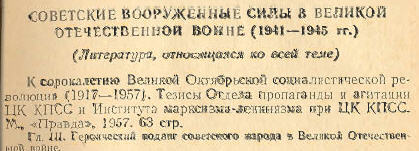

Armiia i flot Rossii. O vooruzhennykh silakh Rossii, SSSR i Rossiiskoi Federatsii: Bibliograficheskie i metodicheskie materialy.
Rossiiskaia gosudarstvennaia biblioteka. Otdel voennoi literatury. Sostaviteli N.V. Doshchenkova, O.F. Reutova, Moskva: Pashkov dom, 2002.
U of I Library Call Number: International & Area Studies Russian Reference (Slavic) and Main Stacks 016.35500947 L897a
The bibliography is divided into three main parts. The chapter “Russia’s Armed Forces”, which includes works on the history of the Russian Army (except the October Revolution). A large part is dedicated to the contemporary armed services of the Russian Federation. Well represented are works on different types of units, armaments and military technology, and military education. The chapter “In the service of the Homeland” includes materials related to the functioning of the military draft in Russia, professional military service, laws controlling the services provided to military families, general laws governing military affairs of the country. In the chapter “Fidelity to the military duty” the authors present books on the socio-political indoctrination of the servicemen, bibliographical works on famous military leaders, as well as publications on the symbols and medals of Russian and Soviet armed forces.
The addendum to the volume includes, “The Federal Law on the Days of Military Glory (Victory Days) of Russia” Federalnyi zakon o dniakh voinskoi slavy (pobednykh dniakh) Rossii. Also included are addresses of the military colleges of the Ministry of Defense, Ministry of Interior Affairs (MVD) and the Border Patrol (FPS). There are also addresses of the Suvorov and Nakhimov schools, as well as the Cadet Corps and the rules of applying to these schools.
The material within chapters is organized, as authors put it, on the principle of “from the general to the detailed”. Works listed by the branch of service and type of unit. In the subchapter on the victories and great historical events, the arrangement is chronological. The work includes author index. The bibliography is not intended to be exhaustive, but has a selective (rekomendatelnyi) character.


Dni voinskoi slavy Rossii: Annotirovannyi bibliograficheskii ukazatel i metodicheskie materialy.
Rossiiskaia gosudarstvennaia biblioteka; I.S. Baushev (ed.)., Moskva: Pashkov dom, 2005.
U of I Library Call Number: International & Area Studies Russian Reference (Slavic) 016.35500947 D649
The work has been published within the governmental program “Patrioticheskie vospitanie grazhdan Rossiiskoi Federatsii na 2001-2005 gody.” (This alone triggers the same caveats one normally includes when annotating a rekomendatelnyi ukazatel’ from the Soviet period).
The first part of the guide is arranged by the 13 days officially designated as commemorating the victories of Russian and Soviet armies, ranging from the battle of Alexander Nevsky with the Teutonic Knights at Lake Peipus (18th April) to the Day of Victory (Den Pobedy) of WWII (9th May).
Each of the entries for a particular victory opens with a brief description of the event itself, followed by three sections. The first one is devoted to works of general character (Obshchaia literatur), followed by a section listing works of fiction devoted to the event, and finally a section with a bibliography of articles from periodicals. All monograph entries contain brief annotations.
The second part of the book is probably more of interest for political scientists than military historians. It is titled “Metodicheskie materialy v pomoshch bibliotechnym rabotnikam” and besides annotated entries on works depicting Russian military glory includes instructions on organizing conferences and exhibitions on the subject.
The book has an author/title index. There is also an appendix with various government documents, addressing the issue of “patriotic upbringing of the citizens of the Russian Federation.”
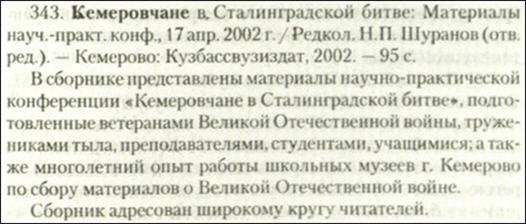

Materialy k bibliografii russskoi voennoi pechati za rubezhom.
Gering, Aleksei., Paris: Passé militaire, 1968.
U of I Library Call Number: International & Area Studies Russian Reference (Slavic) and Main Stacks 016.3550947 g31m
This work is an effort of an émigré naval officer, Aleksei Gering. It was initially serialized on the pages of “Voennaia byl.'” Although the author modestly hesitates to call his book a bibliography, nevertheless it is a very interesting source which provides access to rare materials that were not described in other works. The materials included in the guide include reference works, military history and science, memoir literature, and belles-lettres on military themes or authored by Russian soldiers and sailors. All entries are annotated.
The bibliography opens with a Voennyi otdel (arranged alphabetically), followed by a Voenno-morskoi otdel. The second includes a reprinting of Russkaia Morskaia Zarubezhnaia Bbiblioteka, which was a register of works of Russian naval officers on naval themes published by a Prague émigré journal “Morskoi Zhurnal.” The works that were registered in the Biblioteka are listed chronologically by date of publication. The naval section closes with a chronological list of works that did not get included in the Biblioteka, as well as annotated lists of Russian naval, general military, and Cossack émigré journals.
A 2nd edition, revised and enlarged by Anatol Shmelev is forthcoming in 2007 from Ross Publishing.
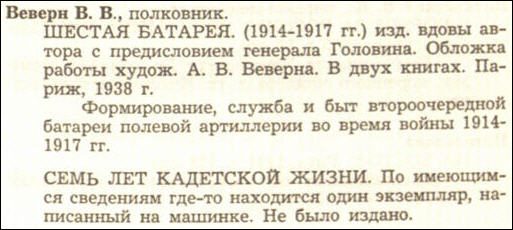

Pervaia mirovaia voina: ukazatel literatury 1914-1993 gg.
Moskva: RAN, 1994.
U of I Library Call Number: International & Area Studies Russian Reference 016.940347 P435
The bibliography lists information on books and brochures in Russian, published in the years 1914-1993 and held by the library of INION RAN. Documents which are listed in the bibliography are grouped by year of publication and then alphabetically by author within each section. The work includes an author index.
Excluded are works which bear no dates, some works which showed particular problems with description and classification, works dealing with food production and distribution, materials of Vserossiiskii soiuz gorodov, and materials produced by the Verkhovnyi sovet regarding the care of families of those called to military service, and families of wounded and fallen soldiers.
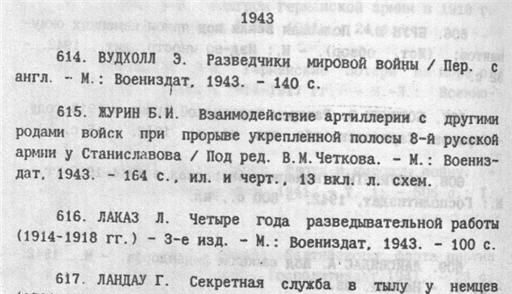

Mirovaia imperialisticheskaia voina 1914-18 gg.: sistematicheskii ukazatel knizhnoi i stateinoi voenno-istoricheskoi literatury za 1914-1935 gg.
Khmelevskii, G., Moskva: Voennaia Akademiia RKKA im. M.V. Frunze, 1936.
U of I Library Call Number: International & Area Studies Russian Reference (Slavic) 016.940916 K52m
The guide lists literature in Russian on land warfare during WWI (1914-1918). Included are monographs and periodical articles. The emphasis is placed on items shedding light on the operational and tactical aspects of the war. The literature included was published in the years 1914-1935. For years 1914-1922 the guide is based on the sources held in the Biblioteka Voennoi akademii RKKA im. M.V. Frunze . Most of the items listed in the bibliography have been described de visu.
The bulk of the work’s entries are arranged by theatre of operation, and within those chapters the arrangement is chronological by year. Approximately a third of the text is devoted to military science (operativnoe iskusstvo) and military technology, with chapters on storming fortifications, use of intelligence, use of particular types of units, etc. There are also a few brief separate sections — besides the obligatory one on Lenin’s views on war, more interestingly there is one on memoir literature.
Most of the entries contain brief annotations, which are usually a brief summation of the work’s contents. The guide is accompanied by author and subject indexes.


Voennye voprosy v dokumentakh KPSS i Sovetskogo gosudarstva: Annotirovannyi bibliograficheskii ukazatel [okt. 1917-iul 1979 g].
Gosudarstvennaia biblioteka SSSR im. V.I. Lenina. Voennyi otdel, Moskva: Voenizdat, 1980.
U of I Library Call Number: Main Stacks 016.3550947 M85V
This works follows several more fragmentary attempts to present the subject of military issues, as reflected in the documents of the Soviet government and the Communist Party of the USSR. Listed are documents devoted in their entirety to military matters, and those which do so only in part. The bulk of the work is devoted to entries on resolutions of the All-Soviet Plenum of the Central Committee KPSS, as well as the plenums of the committees of individual Soviet republics. Included are also all other types of documents generated by the Central Committees, as well as laws of the Soviet government and such organizations as Council of Labor an Defence (Sovet Truda i Oborony) and State Committee on Defense (Gosudarstvennyi Komitet Oborony). Particular attention is given to the lectures of the first secretary of the KPSS, Chairman of the Presidium of the Supreme Sovet of the USSR, Chairman of the Council of Labor and Defense (Sovet Truda i Oborony).
Included are also some documents of joint military announcements from meetings with the communist parties of the other countries of the Warsaw Pact. There is also a selection of the orders of Revolutionary-Military Council (Revvoensovet Respubliki) and People’s Commisariat for Military Matters. (Narodnyi komisariat po voennym delam).
All in all, the work includes over 1000 documents, all of which have been selected from previously published materials. Most entries are annotated. The description includes the description of the type of document, name of the issuing body, a brief summary of the contents, and the source where the document was first published. The book contains a chronological list of all included documents.
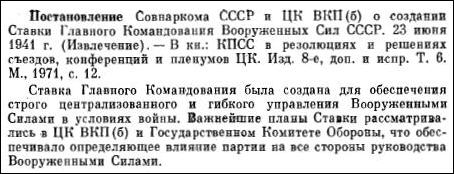

The Russian Imperial Army: A Bibliography of Regimental Histories and Related Works.
Compiled and edited by M. Lyons., Stanford: Hoover, 1968. (Hoover Institution Bibliographic Series: XXXV). 173 pages, index.
U of I Library Call Number: International & Area Studies Russian Reference (Slavic) and Main Stacks 016.355310947 L995R
In the preface to the work Prof. Lobanov-Rostovsky, paraphrasing Tolstoy, writes: “…The regiment in Russia was more than a military unit: it was an organic whole and a kind of alternate home for its members.” (p. xiv). This unique character developed over the years, sometimes centuries, by various regiments has led to a large number of regimental histories. The volume lists “all pre-revolutionary and post-revolutionary regimental histories of the Russian Imperial Army, so far as can be ascertained, along with all other relevant bibliographical information available.” (p. 3) The bibliography also lists other works associated with the topic, such as albums of uniform plates. Memoirs of officers are not included, unless the entire work was devoted to the regiment.
Due to enormous volume, only a small sampling of entries from prerevolutionary journals and newspapers, as well as postrevolutionary émigré press, is included. The work lists some unpublished manuscripts, noting the archive they are deposited in before the Revolution.
The material is arranged in three parts, reflecting the makeup of the Russian Army: Imperial Guards, Grenadiers, and Line. Within these chapters the works are listed by unit.


Soviet Disarmament Policy 1917-1963: An annotated Bibliography of Soviet and Western Sources.
Compiled by Walter C. Clemens, Jr., (Hoover Institution Bibliographical Series: XXII). Stanford: Hoover, 1965.
U of I Library Call Number: Main Stacks 016.32747 C59S
This bibliography is “an attempt to make a comprehensive list under one cover of the basic documents, books, and serials which will contribute to a well-rounded view of Soviet disarmament policy.” The works included have been published between 1917 and 1965, many of them are housed in the Hoover Institution’s library.
The work opens with an extensive foreword, which gives a detailed account of the methodology used. It also gives a number of suggestions for further reading and research. The author included in the list virtually all Soviet monographs he was able to trace. As for periodical articles, the ones included are those which struck the author as “significant”. Documents originating from international conferences and Soviet Communist Party meetings are also listed. The bibliography lists predominantly Soviet publications, although some non-Soviet, Western and League of Nations publications are also included on a selective basis. The work provides a list of periodicals in Russian and Western languages which regularly publish works on disarmament. Also given is a list of bibliographies, both Western and Communist on the subject of disarmament. The annotations provided for most entries comment on the basic tenets of the work and often provide additional information on the author or the context of its publication. The work provides an index.
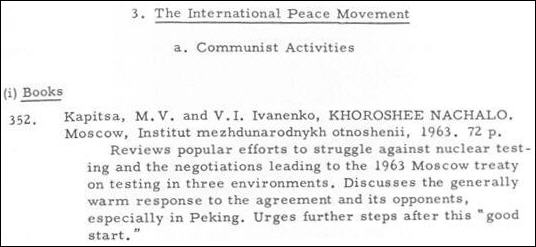

Velikaia Otechestvennaia voina sovetskogo naroda: ukazatel literatury.
Chesnokova, V.S. and A.B. Belizheva., Moskva: Vsesoiuznaia knizhnaia palata, 1942.
U of I Library Call Number: International & Area Studies Russian Reference (Slavic) 016.9409347 C42v
The guide, the first Soviet attempt at a bibliography of works on WWII, lists books and journal articles published from June 23, 1941 — June 1, 1942. It also lists articles published in the main newspapers from June 23, 1941 – April 1, 1942. If a work came out first as a periodical article and then was republished separately, e.g. as a brochure, the listing is done according to the earlier version in the newspaper or journal, and if the brochure was published by one of the central publishing houses it is also listed. All publications by small, local presses are omitted.
The work, predictably opens with the obligatory listing of words of wisdom by the “classics” (Marx, Engels, Lenin) on the nature of wars in defense of the homeland. It is followed by a large section, comprising one third of the book, by works of Stalin on the subject of the war. The section that follows gives works by “people of Stalin’s mold” -military commanders, comissars, political officers, etc. A subsection deals with the partisan war.
The next section lists works of literature commenting on the Soviet war effort. Following that, we find a substantial section on the “united front against fascism”, in which there are subsections on the participation of other countries in the war and their relationship with the USSR. Mentioned are the United States, Great Britain, Poland, Czechoslovakia, France, and Iran. The final section of the bibliography bears the title, “Heroic traditions of the Russian nation” and deals with inspirational works highlighting the might of the Russian army and nation in wars of the past, going all the way back to the Middle Ages.
The sections are arranged alphabetically by author, with the exception of works by Stalin, Molotov, and instructional sources (direktivnye istochniki), which are always listed at the head of each section. The final chapter on the “heroic traditions” is divided by subject and in a chronological order of the events described. The bibliography lists only works in Russian, thus publications in the languages of Soviet republics is not included.
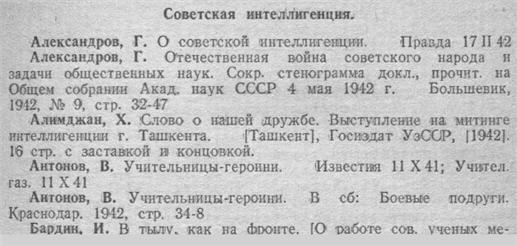

Velikaia Otechestvennaia voina Sovetskogo Soiuza (1941-1945 gg.): Bibliografiia sovetskoi istoricheskoi literatury za 1946-1959 gg.
sost. G.A. Kumanev., Moskva: AN SSSR, Institut Istorii, 1960.
U of I Library Call Number: International & Area Studies Russian Reference 016.9409437 Ak11v
The bibliography lists books, brochures, journal and some newspaper articles on the subject of WWII published in the years 1946-1959. Some of the items included have been published in 1960. The author stresses in the foreword that the work does not claim to be complete, but rather is the first attempt towards a comprehensive bibliography on the subject.
The material is divided into 13 chapters, which are further subdivided into subchapters. Within these the material is presented alphabetically. There are chapters devoted to general political, social, and economic issues, as well as ones devoted strictly to military matters. The latter ones comprise the bulk of the work. The bibliography has a chapter devoted to recipients of the Hero of the Soviet Union decoration.There is also an appendix – “Kratkii spisok bibliograficheskikh ukazatelei” which lists 18 bibliographic works on the subject of WWII.


The Soviet Armed Forces: Books in English, 1950-1967.
Parrish, Michael., Stanford: Hoover Institution Press, 1970. 128 pp. (Hoover Institution Bibliographical Series: XLVIII ).
U of I Library Call Number: Main Stacks A.940.91L53B no.48
This bibliography is an attempt to organize the large body of publications which arose in the West in response to the growing military might of the USSR. The publication lists books, journals (many of which had not been indexed elsewhere), documents, and special studies. Also included are translations from Soviet sources published by the Joint Publications Research Service of the U.S. Department of Commerce.
The bibliography is divided into subject areas, most of which are related to a particular type of military forces, such as Air Force, Artillery, etc. There are also chapters on general subjects such as Strategy and Theory, Party Military Relations, etc. No annotations are provided. The work contains an author index.


World War II: Books in English, 1945-65.
Compiled by Janet Ziegler., Stanford: Hoover Institution Press, 1971.
U of I Library Call Number: Main Stacks A.940.91L53b no.45; Oak Street Facility 016.94093 Z62W
This work is an attempt to fill a gap in the bibliographic coverage of the publications on the subject of World War II. The bibliography aims at presenting a comprehensive coverage of the books published in English during 1945-1965. With a few exceptions, listed are only works of fifty pages or more. Excluded are government publications (except official histories and other primarily historical works), fiction, poetry, works of purely humorous or artistic content. The works listed are not annotated. Wherever multiple editions are involved, chronological order is observed. The very detailed table of contents greatly aids in navigating the source and serves almost as a form of a subject index. There is also an index of authors and major series.
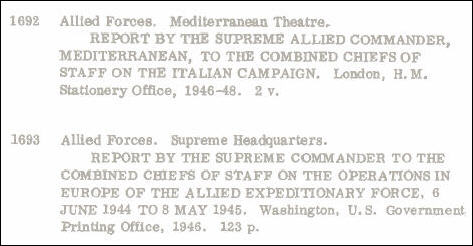

Bibliographies of Bibliography
Bibliografiia russkoi voennoi bibliografi: Sistematicheskii perechen osnovnykh bibliograficheskikh ukazatelei s nachala XIX veka do Velikoi Oktiabrskoi sotsialisticheskoi revoliutsii.
Levasheva, Z.P., Moskva: Gosudarstvennaia biblioteka SSSR, Voennyi otdel, 1950. (Reprinted in Great Britain by Oriental Research Partners, Cambridge, England)
U of I Library Call Number: International & Area Studies Russian Reference (Slavic) 016.355 L57B
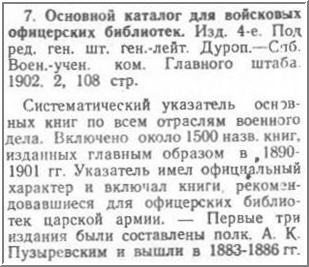
The work is the effort of the Voennyi otdel of the Russian State Library. It is the second part of the work, also edited by Z.P. Levasheva — “Bibliografiia sovetskoi voennoi Bibliografii. Sistematicheskii perechen osnovnykh bibliograficheskikh ukazatelei za 1938-1947 gg” Moskva: 1948.
This second part lists guides that were published from the beginning of the 19th century up to the Revolution. Included are bibliographical guides, as well as all other types of lists, whether published separately or those which appeared within monographs and periodicals.
The guide does not include certain types of materials such as: bibliographies of manuscripts, or of exclusively foreign materials, journal indexes spanning a year of less, library catalogs of military unit and military academies of all types, and guides published as lithographs. General bibliographies which include chapters on military matters were also not included. A name and subject indexes are provided.

Bibliografiia sovetskoi voennoi bibliografii: sistematicheskii perechen osnovnykh bibliograficheskikh ukazatelei za 1938-1947 gg.
Levasheva, Z.P., (P.I. Karklin, ed.) U of I Library Call Number: FILM 016.355 L57BI
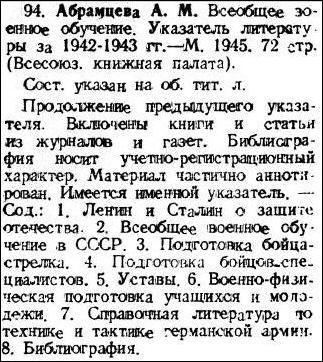
The bibliography was compiled from the resources of the Voennyi otdel Gosudarstvennoi ordena Lenina biblioteki SSSR imeni V.I. Lenina
The bibliography lists guides (ukazateli), lists (spiski) and literature surveys (obzory), both those published separately, as well as printed in periodicals. Some ukazateli of general character, which contain a section on military literature, were also included. Unfortunately, newspaper articles, local and small print run publications have not been included.
The arrangement of the guide varies from chapter to chapter. Most of the chapters are organized by subject, chapter III (on military history) is set up chronologically by the date of described events, chapters II, XVIII and XXI are arranged alphabetically by author’s name (when no author is listed, the arrangement is by title). All entries are annotated, some of which include citations of reviews. The work includes a name and a subject index.

Bibliografiia sovetskoi voennoi bibliografii: sistematicheskii perechen bibliograficheskikh ukazatelei za 1948-1957 gg.
Levasheva, Z.P. and K.V. Sinitsyna., Moskva: Gosudarstvennaia biblioteka SSSR im. V.I. Lenina, Voennyi Otdel, 1959.
U of I Library Call Number: History, Philosophy, and Newspaper FILM 016.355 L57bi
This is the third installment in the series of guides to Russian/Soviet military bibliographies put out by the librarians of the Voennyi Otdel of the Leninka. The bibliography claims not to have a rekomendatelnyi character, neither does it claim to be comprehensive. Some selection was done by the editors who “attempted to include these bibliographies that retained their reference value for scientific work”. Although primacy was given to more lengthy works, shorter bibliographies were included if they had unique scope or contained particularly valuable annotations. Some bibliographies of more general character are also listed if they contained a considerable amount of military-related material.
Not included are year-long indexes to military periodicals, brief bibliographies contained within books or articles, bibliographical materials published in newspapers, and those listing exclusively works published abroad. The material within the bibliography is grouped by subject, with the larger and more general works listed at the beginning of each section. The work includes a name and a subject indexes.

Soviet Sources of Military Doctrine and Strategy.
Scott, William F., New York: Crane, Russak & Company, Inc. 72 pp.
U of I Library Call Number: Main Stacks and Oak Street Facility 016.3550947 SCO8S
The work provides an “annotated bibliography of Soviet newspapers, journals, and some 168 books containing significant material on military doctrine and strategy between the years 1960 and 1974.” The initial chapters of the book provide a good overview of the general nature of Soviet military writings, the institutional and unit affiliation of the authors who can be expected to authoritatively write on military matters, as well as the basic printed sources (both military and non-military), periodicals and monographs, which should be examined for the most vital information.
The bulk of the work is comprised of a chronological list of Soviet books and pamphlets on military doctrine and strategy, 1950-1974. The annotations, besides the bibliographical information, contain brief assessment of the main themes and importance of the work, its place in the general military/historical context, etc. The final section of the book is devoted to English translations of Soviet military books.
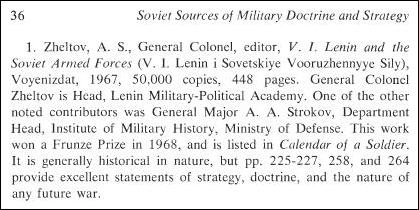

Biography
Vooruzhennye sily Rossiiskoi Federatsii: Biograficheskii spravochnik.
Gazukin, Pavel., Moskva: “Panorama,” 1995.
U of I Library Call Number: Slavic Reference Q. 355.00922 G259v1995
This is the second, corrected and expanded edition. It contains over 80 biographies of the higher-echelon commanders of Russia’s military. The length of entries varies greatly from a paragraph to several pages.
There is also a series of appendixes:
- a short historical sketch on the formation of Russian Ministry of Defense
- a list of military districts ( voennye okruga Booruzhennykh Sil Rossii )
- a list of fleets and flotillas of the Russian Navy
- main groupings of Russian peacekeeping forces, ( Mirotvorcheskie Sily Rossii ), stationed at home and abroad


Admiraly i generaly Voenno-Morskogo Flota SSSR v period Velikoi Otechestvennoi i sovetsko-iaponskoi voin (1941-1945).
Lure, V.M., Sankt: Peterburg: Russko-Baltiiskii informatsionnyi tsentr “BLITs,” 2001.
U of I Library Call Number: International & Area Studies Russian Reference (Slavic) Q. 940.545947 L966a
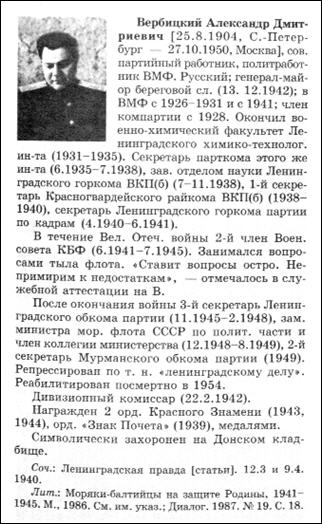
This biographical dictionary provides entries for admirals and generals of the Soviet fleet who served in the years 1941-1945. Among the total of 378 biographies, there are 61 biograms of members of special units, counterintelligence, medical and judiciary personnel.
Each entry is accompanied by a list of publications by the subject of the entry, as well as sources where the person is mentioned, and a listing of archives (with fond and delo specified) where documents related to the person are kept.

Belye generaly vostochnogo fronta Grazhdanskoi voiny: biograficheskii spravochnik.
Volkov, E.V., N.D. Egorov, and I. V. Kuptsov., Moskva: Russkii put: 2003.
U of I Library Call Number: International & Area Studies Russian Reference (Slavic) 355.0092 V885b
The work presents 605 biographies of generals and admirals serving in the White Army on the eastern fronts of the civil war: in the Povolzhe, Ural, and Zabaikale regions, as well as Siberia and the Far East. The entries vary greatly in length, depending on the availability of material. The shorter entries may actually be of more research value, since they include information on some quite minor figures. The work concludes with a bibliography of sources used in compiling the dictionary, including the list of archival collections consulted.


Biograficheskii spravochnik vysshikh chinov Dobrovolcheskoi armii i Vooruzhennykh sil iuga Rossii: Materialy k istorii Belogo dvizheniia.
Rutych, N., Moskva: “Regnum” – “Rossiiskii arkhiv,” 1997.
U of I Library Call Number: International & Area Studies Russian Reference 947.08410092 R939B
This biographical guide has been compiled on the basis of a wide range of sources. These include previously published guides, from Russian and foreign archives, émigré press, publications of émigré veteran associations, and interviews with surviving members of the White Army. The entries are quite substantial and some of the citations are referenced in notes. There is also a name index.
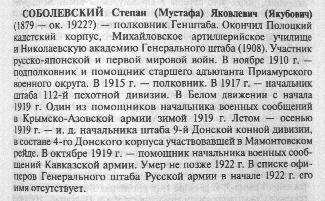

Biografii rossiiskikh generalissmussov i general-feldmarshalov s 48 portretami.
Bantysh-Kamenskii, Dmitrii., Sanktpeterburg: V tipografii Tretiago Departamenta Ministerstva Gosudarstvennykh Imushchestv, 1840. 4 vols in 2.
U of I Library Call Number: International & Area Studies Russian Reference (Slavic) 923.547B22b. This source has been digitized by HathiTrust and is available as an e-resource through our catalog here.
The work presents 45 biographies of Russian commanders who have reached the ranks of field marshal and generalissimus. The biographies are listed within chapters, each one devoted to the reign of a particular tsar, from Peter the Great to Nicholas I. The biographies are written in depth, comprising of several pages per entry, with numerous footnotes of bibliographical and informational nature. The entries are accompanied by portraits.
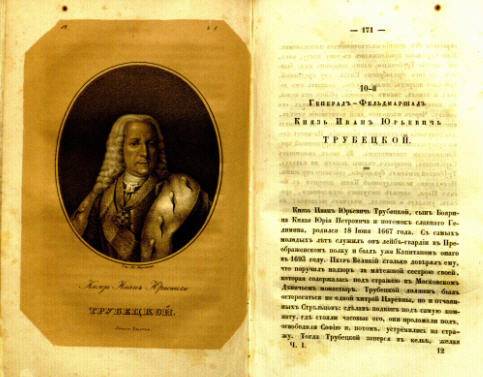

Marshaly Sovetskogo Soiuza. Lichnye dela rasskazyvaiut.
Insitut voennykh i istoriko-patrioticheskikh problem i issledovanii, Moskva: Liubimaia kniga, 1996. 96p.
U of I Library Call Number: International & Area Studies Russian Reference (Slavic) 355.3310922 M355
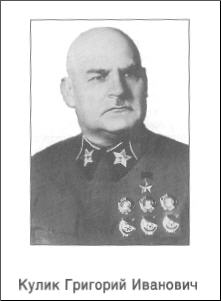
This volume provides entries for 41 Marshals of the Soviet Union. The authors claim the work differs from similar sources in that the entries were “composed based on the works authored by the marshals themselves and on statements of their immediate superiors.” The work is illustrated with portraits of the marshals and with color photos of the marshal uniform from different time periods.

Belyi front generala Iudenicha. Biografii chinov Severo-Zapadnoi armii.
Rumych, N., Moskva: Russkii put, 2002.
U of I Library Call Number: International & Area Studies Russian Reference 355.3310947 R939b
The work opens with an in-depth biography of general Iudenich and then presents 51 biographies of officers of his Northwest Army. In the next section we find 11 bios of the organizers of the anti-Bolshevik uprising in Petrograd.
The entries are accompanied by lists of bibliographic works used in their creation. The work has been researched largely on the basis of source materials found in Russian archives. It contains a name index and several plates with portraits and period photographs.


Evrei-generaly vooruzhennykh sil SSSR: Kratkie biografii.
Sverdlov, F.D., Moskva, 1993.
U of I Library Call Number: International & Area Studies Russian Reference (Slavic) 355.0092 Sv26e
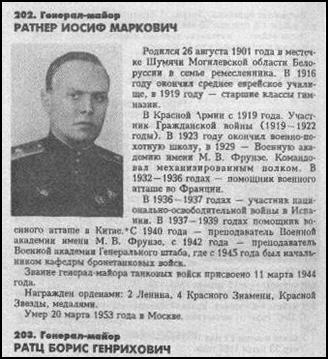
The work presents 305 biographies of Soviet generals and admirals of Jewish background. The time frame of the biographies is not explicitly stated. Virtually all of the generals took part in WWII, however, some of them rose to the general’s rank already after the war.
The work contains an appendix listing the high ranking Jewish officers (voenachalniki) who were executed during the purges of 1939-1940. The entries in the appendix contain only name and rank of the purged officer.
The appendices to the work contain name lists of Jewish generals who commanded a front or a voennyi okrug, an army or a flotilla, who were chiefs of staff of a fleet, a flotilla, or an okrug . There are also lists of those who were in charge of a corps or a division. The arrangement of the work is alphabetical by name. Most of the entries are accompanied by portraits of the generals.

Voennyi orden Sviatogo Velikomuchenika i Pobedonostsa Georgiia: imennye spiski 1769-1920: biobibliograficheskii spravochnik.
V.M. Shabanov (ed.)., Moskva: Russkii mir, 2004.
U of I Library Call Number: International & Area Studies Russian Reference (Slavic) 947.00922 V857
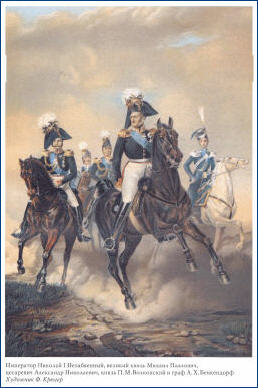
The work lists the names of the recipients The Order of St. George tsarist Russia’s highest exclusively military order. The order, instituted in 1769 by Catherine the Great, was awarded to officers and generals for gallantry in the face of enemy. The order had four degrees and could be accompanied by an additional award of St. George’s Weapon (Georgievskoe oruzhie) – a golden saber.
The work begins with a historical background of the order, appending full text of numerous statutes and documents related to the order’s history. The bulk of the work is bio-bibliographical and is divided into the following parts:
- Lists of recipients of the Order of St. George of the 1st, 2nd, and 3rd class, decorated in 1769-1918, with a description of their gallant deeds in the field;
- List of orders of St. George, 4th class, awarded in 1769-1869;
- Alphabetical list of recipients of the Order of St. George, 4th class, decorated in 1870-1888;
- Alphabetical list of the recipients of the Order of St. George, 4th class, decorated during a march on China in 1900-1901 and during the Russo-Japanese war 1904-1905;
- Alphabetical list of the recipients of the order of St. George and St. George’s Weapon, decorated for valor during WWI 1914-1918;
- List of the recipients of the Order of St. George and St. George’s Weapon, decorated during the Civil War 1918-1920; and
- Addendums:
- List of the Russian Imperial Army units decorated with the Order of St. George
- List of chaplains decorated with the Golden Cross on St. George’s Ribbon (Napersnyi Zolotoi Krest na Georgievskoi Lente)
Decree of the President of the Russian Federation V.V. Putin on reactivation of the Order of St. George
Depending on the section the entries vary greatly in length, from one-sentence mentions to paragraph-length biographies. Most entries are very heavily abbreviated and require the use of the list of abbreviations provided in the work. There are also numerous colored plates illustrating the various forms of the order as well as showing portraits of recipients.

Georgievskie kavalery: Sbornik v 4-kh tomakh.
A.V. Shishov (ed.)., Moskva: Patriot, 1993.
U of I Library Call Number: Main Stacks 947.00922 G297
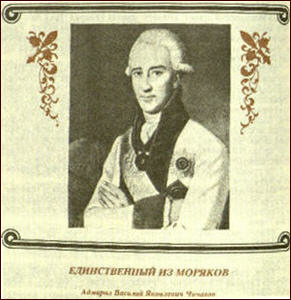
This is another bibliographic source which bases its entries on the list of the recipients of The Order of St. George. The work is planned for four volumes. Volume I covers years 1769-1850, it provides 92 biographical sketches, which unfortunately are not accompanied by bibliographical notes. The work does provide a brief bibliography of works used, as well as a short dictionary of military terms.

Kavalery imperatorskogo voennogo Ordena Sviatogo Velikomuchenika i Pobedonostsa Georgiia I i II stepenei (1769-1916).
Talberg, F.A. and N.I. Podgornaia., Riga: Izd-vo „Lotta Co. Ltd.”
U of I Library Call Number: International & Area Studies Russian Reference (Slavic) 929.8147 T142k
The work presents brief biographical entries on the recipients of the Order of St. George Ist and IInd class. The first two classes on the order were unofficially recognized as being second only to the order of St. Andrew in the hierarchy of imperial awards. On the whole, up to 1917 only 125 orders of 1st and 2nd class were awarded, 18 of these to foreigners. Some of the recipients arrived at the highest two classes by being first decorated with the order IVth class, and then receiving the subsequent classes for further acts of bravery. In other cases, it appears that aristocratic birth and high military rank were very helpful in catapulting one straight to the top two classes.
The entries are accompanied by the statement justifying the award of the decoration. Each entry is illustrated by a large portrait.
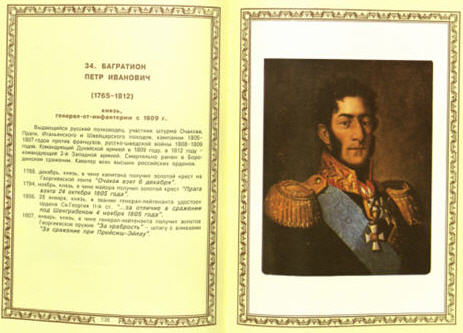

Kto byl kto v Velikoi Otechestvennoi voine. Liudi. Sobytia. Fakty : Kratkii spravochnik.
O.A. Rzhevskii (ed.)., Moskva: Izd-vo „Respublika”, 1995.
U of I Library Call Number: International & Area Studies Russian Reference (Slavic) 940.53470922 K949
The work includes some 1400 biographical entries on the major figures of the Soviet war effort of WWII. Included are major commanders of the Armed forces and the guerilla units, two- and three-time recipients of the order of the Hero of the Soviet Union, and the more famous singly decorated Heroes of the Soviet Union, as well as the recipients of the Order of Glory (Orden Slavy). There are also biographies of major figures of science, industry and art who made significant contributions to the Soviet war effort. The work is illustrated with numerous portraits. There is also an appendix containing a quite detailed (over 100 pages) chronology of the Soviet war with Germany.
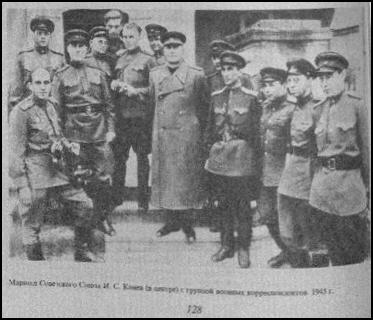

Morskoi biograficheskii spravochnik Dal’nego vostoka Rossii i russkoi Ameriki. XVII-nachalo XX vv.
sost. B.N. Bolgurtsev., Vladivostok: Izd-vo „Ussuri”, 1998.
U of I Library Call Number: International & Area Studies Russian Reference 359.00922 B637m
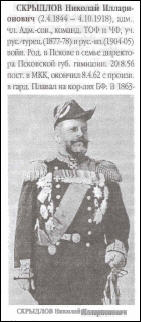
The dictionary contains over 650 biographies of Russians who from the 17th until the beginning of the 20th century participated in the colonization of East Siberia, Russian Far East and the Russian-controlled American territory. Among the biographies are numerous entries for Russian admirals and naval officers. The work contains a name index and is illustrated with small-sized portraits.

Ofitsery armeiskoi kavalerii: Opyt martirologa.
Volkov, S.V., Moskva: Russkii put, 2004.
U of I Library Call Number: Internatiaonl & Area Studies Russian Reference 357.10922 V879o
This work provides information on over 6,800 officers of the cavalry who fell victim to the revolutionary Red Terror, who were killed in the ranks of the White armies in the years 1917-1922, died in emigration, or who were victims of repressions in the 1920s and 1930s. Included are also names of officers who perished during the February uprising in Petrograd and those killed by the soldiers taking the Bolshevik side in the in March-October 1917. Thus the scope of the work includes the names of all the officers of Russia’s cavalry who survived WWI and did not join the Bolsheviks. Included are names of officers who served in the cavalry for any period of time, not necessarily in cavalry ranks in 1917.
The entries are very brief, sometimes consisting only of a couple of lines. The emphasis in the biographies is on the participation in the White movement and activities in the émigré organizations.

Ofitsery flota i morskogo vedomstva: Opyt martirologa.
Volkov, S.V., Moskva: Russkii put, 2004. OCLC: 63765430
This is another one of the Russian military martyrology series. The scope is the same as the one in the other works of S.V. Volkov. It contains over 5,700 entries on Russian naval officers and those attached to the Department of the Navy.

Ofitsery rossiiskoi gvardii: opyt martirologa.
Volkov, S.V., Moskva: Russkii put, 2002.
U of I Library Call Number: Main Stacks 355.3310947 V885o
This biographical dictionary is identical in its approach and scope to that of the “Ofitsery armeiskoi kavalerii” and “Ofitsery flota i morskogo vedomstva,” with the obvious difference being the requirement that the soldiers listed have at some point in their careers served in a Guards unit. The work contains over 5,100 biographies.

Pervaia mirovaia voina: biograficheskii entsiklopedicheskii slovar.
Zalesskii, K.A., Moskva: Veche, 2000. 573 pp.
U of I Library Call Number: Main Stacks 940.400922 Z142p
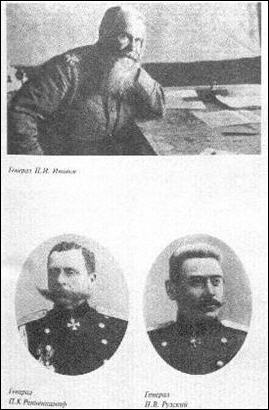
The work attempts to fill the void in Soviet/Russian military biography of the leaders of the Russian Army in World War I. This gap was largely due to the fact that many top Russian commanders fought on the side of the Whites in the revolutionary war, which followed the end of the world conflict. This caused their biographies to be largely omitted in Soviet historical works, while a host of bios of military men who chose the communist side, were published en masse, after considerable alteration of historical fact.
This work is largely based on the 46th volume of Entsiklopedicheskii Slovar Granat, where gen. Evgenii Ivanovich Martynov published a supplement “Voennye deiateli epokhi mirovoi voiny.” The work is a considerable expansion of Martynov’s supplement, enlarging it from 133 to 329 entries. Furthermore, those entries which are included in the Granat have been considerably expanded, so that the total amount of text has been enlarged threefold, using the available foreign and Russian sources. The entries are quite extensive, varying greatly in length, depending on the availability of source materials.
The work concludes with extensive appendices, which include the list of the general staffs of the German, Austro-Hungarian, Bulgarian, Turkish, French, British, American, Italian, and Serbian armies. Also included are an extremely detailed order of battle of the Russian Army and Fleet in the years 1914-1917, as well as a chronology of the war. The work is separated into parts by participating country, with names of commanders listed in alphabetical order. Navigation is made easier by a name index.

Polkovodtsy Rossii. 1995.
E.I. Kiselev (ed.)., Nizhnii Novgorod: Izd-vo “Nizhnii Novgorod”, 1995.
U of I Library Call Number: Main Stacks 355.00922 P759
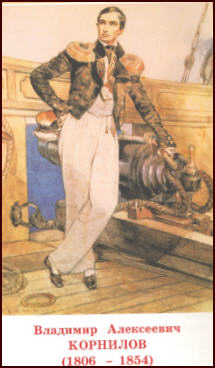
The work presents twenty biographies of outstanding Russian commanders, from Alexander Nevsky to Georgii Zhukov. The entries are quite lengthy and a list of sources used in their writing is provided at the end of each chapter. The work, although aimed for a more general audience, provides a wealth of detailed information. The book is illustrated with period painting reproductions, while each entry shows a portrait of the commander it describes.

Russkie voennye vostokovedy do 1917 goda: Biobibliograficheskii slovar .
Baskhanov, M.K., Moskva: “Vostochnaia literatura” RAN, 2005.
U of I Library Call Number: International & Area Studies Russian Reference (Slavic) 355.00922 R921
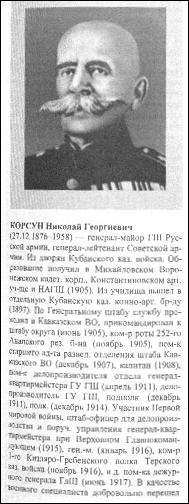
The biobibligraphical dictionary offers some 400 entries on Russian officers-orientalists ( ofitsery-vostokovedy ) who served in the Imperial Army from the middle of the XIX-th century until 1917. Included are officers of all ranks, from lieutenants to generals. The official designation of ofitser-vostokoved (ofitser-orientalist) was established in the beginning of the XX-th century and underscored the importance the Russian military attached to the research and understanding of that part of the world, both within and without the boundaries of the Russian Empire. Officers-orientalists were assigned to the border regions, attached to the staff of administrative units, from the size of a military district ( voennyi okrug ) to individual outposts.
The work these officers produced was published in a series of military-orientalist publications, such as “Sbornik geograficheskikh, topograficheskikh i statisticheskikh materialov po Azii.,” “Vestnik Tashkentskoi ofitserskoi shkoly vostochnykh iazykov,” “Svedeniia, kasaiushchiesia stran, sopredelnykh s Turkestanskim voennym okrugom,” “Izvestiia shtaba Kavkazskogo voennogo okruga,” “Kitai i Iaponiia,” “Materialy po Manchurii, Mongolii, Kitaiu i Iaponii.”
The dictionary has an alphabetical arrangement. Entries are accompanied with bibliographies of work on and by the entry subjects. The work offers a unique look at a little-researched chapter in Russian military history, as well as providing an opportunity for tracing relatively detailed biographies of officers of lower ranks.

Voenachalniki Rossiiskoi armii.
Gazukhin, Pavel., Moskva: Tsentr „Panorama”, 2001.
U of I Library Call Number: International & Area Studies Russian Reference (Slavic) 355.00922 G259vo
The source contains 105 biographies of generals and senior officers of the Ministry of Defense, General Staff, and the armed forces of Russia. The entries focus mostly on the education and the history of service, but contain also personal information such as marital status and foreign languages spoken. The information in the guide is current up to August of 2001. The entries vary greatly in length, with more prominent officers receiving more attention.
The work is accompanied by appendices such as a series of tables showing the consecutive time periods during which officers held the most prominent posts in the Russian military hierarchy, such as Ministers and vice Ministers of Defense, Commanders of Military Districts (Komanduiushchie voennymi okrugami), etc. There is also a brief section of contact telephone numbers for different departments of the Ministry of Defense of the Russian Federation.

Soviet Nomenklatura: A Comprehensive Roster of Soviet Civilian and Military Officials.
Albert L. Weeks (compiler)., [Washington D.C] : The Washington Institute Press, 1987.
U of I Library Call Number: International & Area Studies Russian Reference (Slavic) Q. 354.47002 W418s
This work, produced by the now defunct think tank, The Washington Institute for Values in Public Policy, provides listing of Soviet officials of the so-called nomenklatura, the de-facto ruling class of the USSR. The roster is arranged by governmental and party departments. The chapters of interest to military scholars are: the Main Political Directorate of Soviet Army and Navy and the Ministry of Defense. Entries are mostly very brief, often giving only a title of appointment to the position. In the case of the more prominent figures they reach the length of a paragraph.
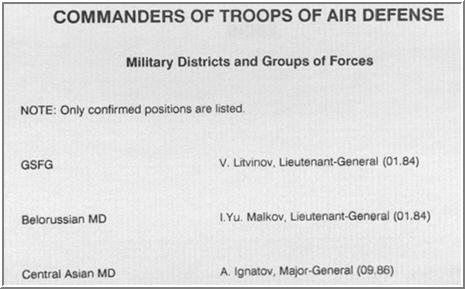

Voennye Rossii.
Krotov, N.I. and A.A. Tsyganov., Moskva: “RAU-Press”, 1992.
U of I Library Call Number: International & Area Studies Russian Reference (Slavic) 355.00922 K928v
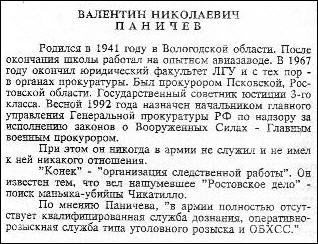
The work provides 40 biographical entries on high-ranking Russian officers who were playing an active role in the political life of Eltsin’s Russia. The book is written in a journalistic style, with the biographical entries full of colorful anecdotal material, quotes, and sometimes quite sensationalist information about the officers’ private lives. The entries are in alphabetical arrangement and the work contains a name index.

Uniforms, Insignia, and Decorations
Nagrudnye znaki Russkoi Armii.
Andolenko, S., Parizh Izd-vo Tanais, 1966.
U of I Library Call Number: International & Area Studies and Main Stacks 355.134 An22n
The guide shows the whole gamut of Russian Imperial military insignia. Presented are the insignia of military academies of all types and levels, Imperial Guard units, the foot regiments (grenadiers, infantry, rifle), cavalry (dragoons, uhlans, hussars), artillery, and Cossack units. The images of the insignia are black and white. Luckily the descriptions make careful note of colors used. Under each item there is a brief identification of the unit in French. The arrangement is by type of arms. The work contains a preface which provides an outline of the history of Russian military decorations.
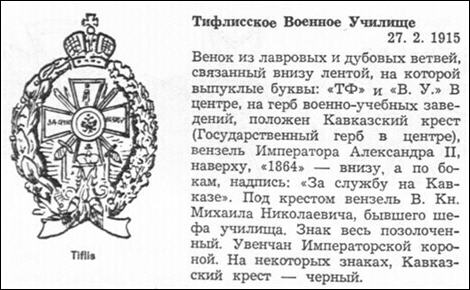

Tablitsy form obmundirovaniia Russkoi Armii (24-e nagliadnykh tablitsy novykh form). Sostavleno po 10 Maia 1910 g.
Shenk, V.K., S.-Peterburg” Knizhnyi i geograficheskii magazin izdanii Glavnago Shtaba, 1910. OCLC: 123241917
The Russian army initiated a reform of uniforms in 1906 and completed it in 1910. It was the first such reform in 25 years, introducing a much greater variety of uniforms for different units and formations. The work presents the results of the reform in the form of tables showing the complete field and dress uniforms, listed by unit. The work is divided into two main parts: Guard units, and Army units. There is no index or a full listing of all units, so the navigation is somewhat cumbersome. Also, the small size of space devoted to each type of uniform almost calls for the use of a magnifying glass.
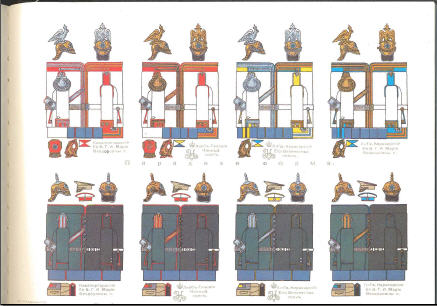

Uniforms of the Imperial Russian Army.
Mollo, Boris, Poole, Dorset: Blandford Press, 1979, 160 pp. OCLC: 6376534
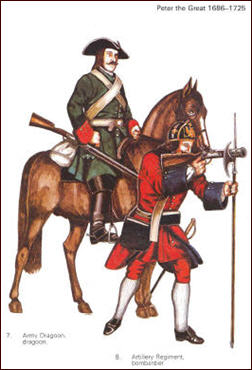
This work, due to its scope, is by necessity only a broad overview of the evolution of the Russian military uniform from 1700 to 1917. The author thus defines his goal, “The aim of this book is to draw attention to the major changes in uniform and to show something of the adaptations, official and unofficial which occurred during the major wars in which the Russian army was involved. It is also necessary to draw attention to the reasons behind the changes, the personalities of the tsars and tsarinas, the influence of other armies and the fashions of the times, all of which profoundly affected uniform design.” (p. vii).
The book opens with the narrative part, which blends the history of the uniform with all the considerations mentioned above. It is divided into the following parts, Peter the Great (1686-1725), Peter’s Successors (1725-1762), Catherine the Great (1762-1796) and Paul I (1796-1801), Alexander I (1801-1825), Nicholas I (1825-1855), Alexander II (1855-1881), Alexander III (1881-1894) and Nicholas II (1894-1917). What follows are 164 plates, described in a separate section and providing a lot of illuminating historical detail. The appendices include, “A List of Regiments of the Imperial Russian Army, 1914”, a glossary of uniform terms, and a bibliography of works on Russian uniform.

Soviet Army Uniforms & Insignia 1945-75.
foreword by Lieut.-Col. A.J. Baker., London: Arms & Armour Press; New York: Hippocrene Books, Inc., 1976.
U of I Library Call Number: Main Stacks 355.14 G79S
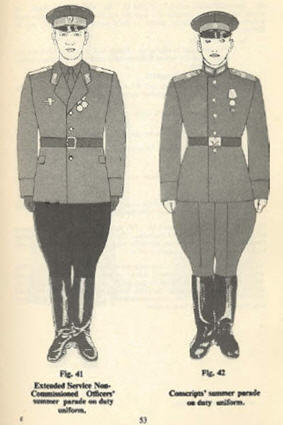
This work is a facsimile compilation of two previously classified pamphlets produced by the War Office, “The Soviet Army: Uniforms and Insignia,” 1950; “Soviet Army Uniforms 1961.” Thus, as the publishers state, “the quality of some of the illustrations […] falls short of the high standard of reproduction normally accepted in modern books.”
The original pamphlets were intended as an aid for Western military personnel in identifying Soviet military counterparts. However, at the time of their republishing, they were already obsolete, since a major uniform reform was introduced in 1969/1970. The introduction to the volume briefly summarizes the changes made, although no illustrations are provided.
The work is divided into two parts, “1950,” “1961.” Since these dates come from two different periods in the Soviet uniform history (there were five major reforms from 1946-1991), they are a good illustration of the evolution of Soviet military garb. Besides field and dress uniform and insignia, there are sections devoted to military decorations. Besides drawings, some photographs of soldiers are included.

Znaki i zhetony Rossiiskogo Imperatorskogo flota 1696-1917.
Dotsenko, V.D., A.D. Boinovich, and V.A. Kupriukhin., Sankt-Peterburg: Logos, 1993.
U of I Library Call Number: Main Stacks 355.13420947 D742
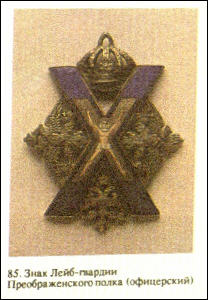
The work presents the insignia of all the units of the Imperial Navy, including those of the naval academies and those of émigré associations of former naval servicemen. The preface outlines the history of Russian naval military badges, while the text itself is in a sense that very history described in vivid detail, with the breast badges and tokens shown in color illustrations. The work is accompanied with a list of illustration in Russian and English.

Voinskie zvaniia.
Ganichev, P.P., Moskva: Izd-vo DOSAAF SSSR, 1989.
U of I Library Call Number: Main Stacks 355.13420947 G155v
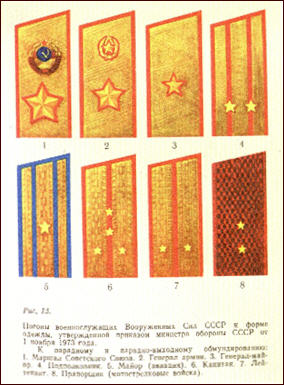
The work provides insight into the evolution of Russian and Soviet military ranks. It consists of chapters on the historical development of the system of ranks. The author provides numerous tables which list both army and naval ranks of different historical periods, including very useful tables which compare the imperial and Soviet rank systems side by side. There is also an extensive dictionary of ranks, with entries providing the use and history of each rank.

Znaki voinskoi doblesti.
Domank, A.S. Moskva: Izd-voo DOSAAF SSSR, 1990.
(2-e izd. prererabotannoe i dopolnennoe)
U of I Library Call Number: Main Stacks 355.13420947 D716Z1990
The focus of this work is on the merit badges of the Soviet Army. The decorations of the Imperial army are treated relatively briefly. Although the work is written as a narrative and does not contain an index, it nevertheless is divided into numerous chapters which allow the reader to focus on the type of merit badges for which one is searching. There are over 200 color illustrations, although one wishes for more.

Websites
Voenno informatsionnyi portal Armiia Rossii

The portal covers a wide range of military subjects, such as law, technology, structure of the Russian armed forces, military education, etc. As with any portal, it sometimes takes a bit of searching to orient oneself and to find worthwhile information. There are sections on the structure of Russian Federation forces, military law, biographical information, etc.
Perhaps the most valuable feature of the site is an extensive list of military-oriented websites: http://tinyurl.com/yslxfq. These range from well-developed historically oriented sites to online discussion forums. The site does have a search engine which aids in navigation.

Voenno-morskoi flot v Internete
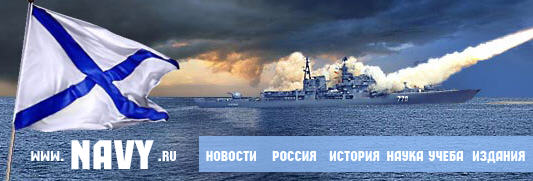
This portal has been in existence for ten years and has won awards for the service and content. The editor of the site is V. Valkov, captain of a nuclear submarine. It links to a whole array of resources including blogs, forums, brief internet-only articles, latest navy-related news, etc. It provides an extensive list of websites connected in some way to the naval forces, not limited only to Russian-language websites, which are listed first. The thematic range (and quality) of the websites reflect the nature of the internet resources on military matters. The sites range from the predictable, well-established ones such as those o the Ministry of Defense of the Russian Federation, to specialized military websites dedicated to types of naval forces, naval badges and insignia, often maintained by individual enthusiasts.
The sections of the site are too numerous to list here. The portal deals with a broad range of issues such as the Russian naval education, naval law, etc. The portal lists naval journals, and some of the links lead to full-text articles. The navigation of the portal is made easier by an internal search engine.

Ministerstvo oborony Rosiiskoi Federatsii
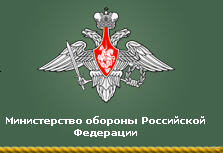
This site of the Russian Defense Ministry contains quite a bit of useful information, ranging from technological specifications of weapons to the war on terror. Some of the headings on the site may not be immediately obvious as to their content and require a bit of exploration. For example, under the general rubric, “Voennaia Entsiklopediia” , we find “Voennaia istoriia v litsakh” -a series of biographical entries on Russian military personages, calendarium of important dates in Russian and Soviet military history, highlights of the latest Russian military hardware, and more. On its front page the site has a section “Novosti” which brings in press releases about the latest developments related to military life.
The site also contains links to the online version of “Krasnaia Zvezda,” “Voenno-istoricheskii zhurnal,” “Voennaia mysl,” with some retrospective archival coverage. Interestingly, the site also prominently links to the website of the military/patriotic TV channel “Telekanal Zvezda” (http://www.tvzvezda.ru/). The site has an English version, although it is quite abbreviated.

Reiting Voennykh Saitov

Hundreds of military sites are linked to, briefly described and rated at this very useful ratings list. Due to the enormity of the list, the quality of the websites varies greatly, but it is indeed an excellent source for browsing. What makes the site manageable to navigate, is that it is possible to group the sites by theme, such as websites of military academies, sites devoted to e.g. a particular type of military units, such as special forces, military history, military technology, military-patriotic organizations, full text of journals, etc. This can be done in two ways: if one finds a site of interest while browsing, then clicking on its subject descriptor will create a list of all the sites sharing the same description. A drop down menu of all the subject headings is also available.
Although the quality of the sites listed is uneven, the strength of the list lies in providing a smorgasbord of choices and a good overview of what is available on the Russian internet regarding military matters. Please note that the note “Not Available” on a particular site list is often misleading, and the site does come up when one clicks on the link.

INION Russian Academy of Sciences Bibliographies
Although not a strictly military database, the search of the Academy bibliography can be very fruitful for works related to military issues. The database includes material in the social sciences and humanities published in the CIS and Eastern Europe. Its coverage includes books, manuscripts, dissertations, and articles from more than 10,000 periodicals. Author-title information is given in the original language of publication; abstracts and keywords are in Russian; subject headings are in both Russian and English. The site is searchable both in English and Russian. There is a subscription based version, which is easy to search. There is also a free version available to search here.

East View Information Services Online Databases

Within the East View Information Services Online Databases website, there is a database called (UDB-MIL) Military & Security Periodicals. It provides access to 56 military-related journals in full text. The majority of these are published in Moscow, but there are also several regional publications represented. The retrospective coverage of the availability of the full text varies from title to title, with most titles beginning their archival holdings in the late 1990s.
The following link leads to the list of publications available. Access to the periodicals requires subscription.
http://online.eastview.com/resources/html/udb-mil.htm.
Eastview is also available through our library here.

ISI Emerging Markets

This enormous database, although not specifically designated as such, can yield a large amount of information on military issues. This database provides data, news and analysis from emerging market countries from both government and private sources. It provides full text news articles, press releases, TV and radio program transcripts and various types of statistics. There are also vast amounts of business and financial information, which is often relevant to military researchers, for example in tracking large arms deals, etc.
The very vastness of the database makes it impossible to describe all best sources and potential uses. However, this much can be said – besides providing some retrospective coverage it is very hard to beat it at providing very recent information from sources not indexed or linked to elsewhere.
The full text links lead to items in Russian and in English derived from some 10,500 local and global publications. The database can be searched in English and in Russian (a helpful Cyrillic keyboard is provided). Please note that due to its sheer size, the database can be somewhat tricky to search. Since there are so many approaches possible for mining it for information, it takes some practice to learn to navigate it efficiently and be satisfied that all possible search strategies have been employed. The database is available to U of I students and faculty through the Online Research Resources. If you are not affiliated with U of I you may want to check with your institution or your local library: it is possible that they provide access to the ISI Emerging Markets.
This is a sample hit from the page. It leads to a full text document.
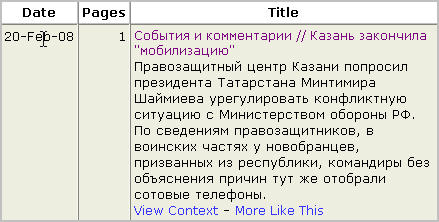

Integrum World Wide
http://www.integrumworld.com/index.html

This is anther very large subscription site, which provides access full text material. It provides on-line access to over 3,500 databases, containing over 123, 000, 000 documents. The database website claims to grow by 10,000 new documents a day.
The site provides full text of both central and regional newspapers, magazines, bulletins. There is also access to breaking news and news archives of the Russian and international news agencies and statistical information. As in the case of ISI Emerging Markets, this database is not dedicated to military matters, but due to its broad scope, can yield a lot of material for the military scholar.

